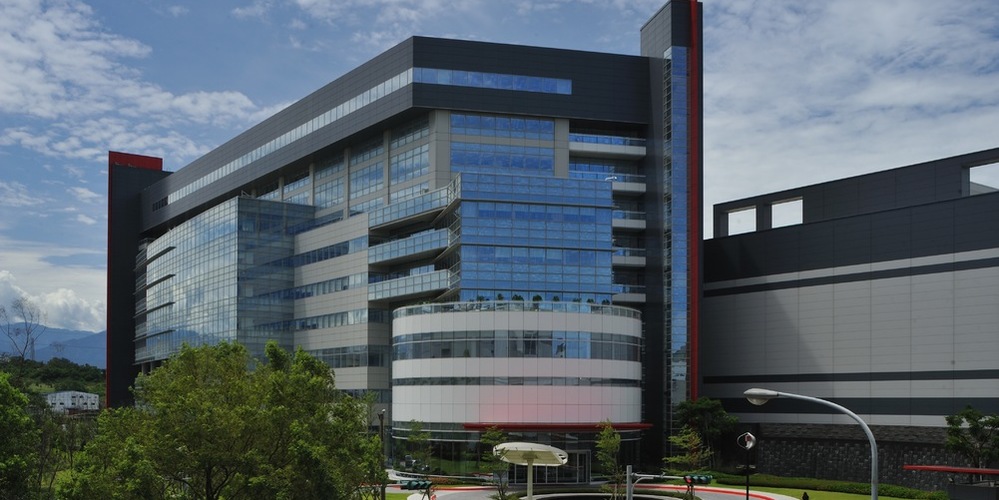
Project Narrative provided by JJ Pan
With an aim to demonstrate the innovative, pioneering work ethics of TSMC, the exterior and design vocabulary of this project is not only a continual expression of the noted corporate identity system, but also statement of “friendliness, transparency, sustainability, and creative interaction” design concepts. The four ideas convey the theme of the project toward people, the corporation, and the environment. Sustainable and environmental concepts are realized through the total planning, architectural design and construction. The recessed green belt shared with the landscape is also employed to establish an eco-aqueduct to enrich biodiversity of the site.
The project site is located in Taiwan's Hsinchu Science Park, a campus being developed to promote high-tech industries since 1980's. Its land use and zoning ordinance have been officially adjusted to industrial use by the governing authority. Currently the traffic and infrastructure systems are ready for supporting the site.
Providing alternative transportation has become an essential part of TSMC corporate culture. All employees are encouraged to utilize public transportation to and from the workplace, as well as between corporate campuses. An increasing number of employees travel via public transportation and TSMC’s commuter service on a daily basis. TSMC’s long-term commitment and dedication to environmental-friendly operation policy can be demonstrated through their consistent development of a highly substantial network of commuter service in partnership with local bus services, various campaigns and continuing education. There is also an array of civic service units provided by different high-tech companies for their employees. These units serve the neighboring communities as well. Services to existing neighborhood include bookstore, convenience store, post office, food court, dental clinic, hair salon, bank, fire station, restaurant, gymnasium and gas station.
F12P4 FAB is designed to establish manufacturing capability of high-nano technology. The facility consists of a wafer fabrication (FAB) building, a hazardous process material (HPM) building, a central utility plant (CUP) building, and an on-site bulk gas plant. The space of wafer production cleanroom is 248,000 ft2 and total FAB / HPM floor space is 2,326,683 ft2. The process ballroom is designed to ISO-5 cleanroom for people and tools environment and the cleanness inside the micro-environment is ISO-2 grade for wafer operation. Following the Uniform Building Code (UBC), the makeup air will not be re-circulated in the HPM building due to safety concerns. F12P4 facility design was initiated in late 2007. The goal of green building design had targeted the LEED’s Gold Rating for both FAB and Office buildings. The FAB construction started in December, 2007, and the commissioning of facilities completed in May, 2009.
This project’s focuses on LEED NC implementation include:
Innovation and design process: F12P4 LEED project team includes LEED certified architects, professionals and commissioning engineers to lead the review of possible points. TSMC also hired professor from National Taipei University of Technology to build a LEED’s energy model to simulate FAB’s operation. The major innovations in F12P4 project include: (1) Easy Public Transportation Access, (2) 100% Underground Parking, (3) Water Use Reduction, and (4) Support Regionalism and Reduce Waste or Pollution Caused by Long-distance Transportation.
Water efficiency: F12P4 is operating an ultra-pure water system with 90% of process water reclaim rate. F12P4 is also equipped with 200,000 US gallons rainwater collection system to increase water resource. 100% of landscaping water will come from rainwater or condensed water from make-up air units (MAU).
Sustainable site: In order to increase the site utilization, TSMC established plenty of community services in the campus, which includes cafeteria, mini-market, bookstore, coffee shop, juice bar, bakery, ATM, laundry, post, and express service. On the issues of transportation services, TSMC has also established a comprehensive bus routes to provide the commute service for its occupants and visitors. Besides, the site is also connected with the Hsinchu Science Park’s shuttle bus services to the high-speed rail station for long distance traveling need. It is estimated that 9,600 tons CO2 emission reduction per year from operating this public transportation service. Also, to minimize heat island effect, F12P4 only provides underground parking for employees.
Energy model: In the design stage, F12P4 utilizes DOE2/eQuest to simulate and analyze the energy efficiency. It has achieved a 21.2% energy performances saving compared to baseline building performance rating per ASHARE standard 90.1-2004. The major contributions are: (1) Varied Frequency Inverter Implementation for Energy Consumed Rotation Machine, (2) Dual Temperature Chilled Water System Built to Maximize the Performance of Chiller, and (3) Implemented the Heat Recovery Design from the Chillers Plant to Cancel the Boiler System Installation that Will Reduce the 2MUSD Investment Cost.